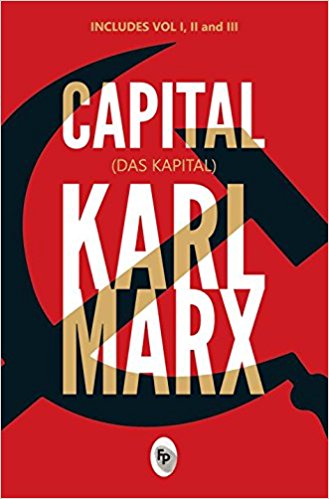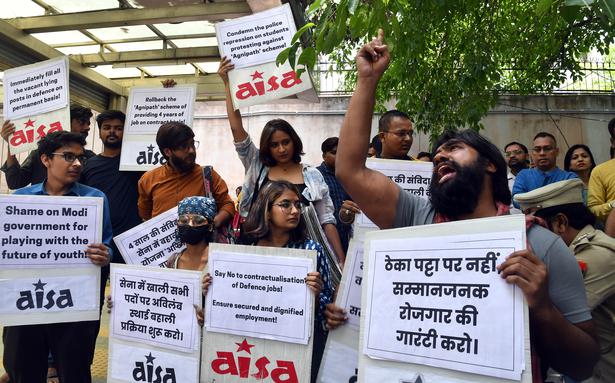150 Years of Marx’s Capital
 150 years back, Karl Marx’s Magnum Opus Das Kapital (Volume I) rolled out of the press on September, 1867. The publication signified nothing short of a silent revolution on the theoretical plane, and the world would never be the same again. Capital soon became the most discussed and debated work. The Russian edition, the first translation of Capital into any foreign language, came out in 1872 in an edition of 3,000 copies, and almost the whole edition was sold out. Forty five years later, as we know, the proletariat in that country would be the first in the world to successfully apply the lessons of Capital in practice.
150 years back, Karl Marx’s Magnum Opus Das Kapital (Volume I) rolled out of the press on September, 1867. The publication signified nothing short of a silent revolution on the theoretical plane, and the world would never be the same again. Capital soon became the most discussed and debated work. The Russian edition, the first translation of Capital into any foreign language, came out in 1872 in an edition of 3,000 copies, and almost the whole edition was sold out. Forty five years later, as we know, the proletariat in that country would be the first in the world to successfully apply the lessons of Capital in practice.
Capital arose out Marx’s never ending research and indefatigable writing and rewriting of 49 manuscripts, amidst penury, ill health and personal trauma. Capital Vol I (1867) focused on the Production process of capital. After Marx’s death in 1883, from manuscripts and the first volume Friedrich Engels introduced Volume II (1885) : The circulation process of capital; and Volume III (1894): The overall process of capitalist production and distribution. These three volumes are collectively known as Das Kapital.
This seminal contribution by Marx thoroughly scrutinized the economic and social reality in the 19th-century northwestern Europe offering an indispensable framework for understanding the essential features of capitalism. Marx’s ‘Capital’ is a journey from the world of appearance to the world of essence. It unravels the man-man relationships behind the veil of thing-thing relationship that capitalism fetishises.
Let’s briefly underline some of the most compelling and unparalleled insights emerging from Capital. Today we are told incessantly that the origin of wealth depends on innovative entrepreneurs, risk takers, visionaries and corporates, who needs to be kept happy and incentivised (ease of doing business) through cutting their taxes, waiving off their loans
and cheapening land and labour because they bring jobs and investment. But where does this ‘wealth for investment’ come from?
Marx’s answer is unequivocal: it has in effect been seized by capital from labour and turned into monetized assets. The source of value is exploited labour power, for labour-power produces more value than it costs in the market and this surplus value is owned and controlled by capital. Indeed, historically capitalist commodity production emerges when labour power
becomes a commodity on a large scale. Thus with his new conceptual insights of labour-power and surplus value, Marx marks a decisive break from bourgeois political economy. Behind the concepts lies a struggle written in sweat and blood as capital seeks to reduce the cost of labour and expand the surplus value which labour-power produces.
Why, one may ask, does the labour have to submit to the exploitation described above? Marx shows us the reason: it is because capitalists have come to own all the means of production (i.e. the means of survival – land, factories, etc), and workers own nothing but their labour power. Capitalism does this by robbing peasants of their land, and workers of their own
tools and implements. In this process, the truly proletarian worker is created – who has lost everything but his own labour. This is the “double freedom” that capitalism offers to the labour, “freedom” from “bondage” and also “freedom” from “all means of production”. Thus separated and “freed” from any private or common ownership of the means of production, labour has no other option to survive but to sell their labour power to the owner of the means of production, the capitalist, in the market place on very unequal terms. Once they lose their land/implements, they no longer have any control over what they produce. Whatever the labourer produces is controlled by the capitalist or landlord.
Marx then meticulously exposes the historical process of the concentration of means of production in the hands of the capitalists through primitive accumulation of capital – the large scale dispossession of means of production of those who previously possessed it, often through violent processes of plunder, conquest and the activity of the merchant and “middleman”. Marx speaks of peasants being “suddenly and forcibly
torn from their means of subsistence” (i.e their land), and “hurled as free…proletarians on the labor market”. Marx writes that the history of this process of forcible grab of means of survival “is written in the annals of mankind in letters of blood and fire.” (Capital Vol I, Ch 26)
In producing capital (produced goods), the workers continually reproduce the economic conditions by which they labour. Capital proposes an explanation of the “laws of motion” of the capitalist economic system-the ever diverging process of concentration of capital in fewer and fewer hands and socialisation of labour– from its origins to its future, by describing the dynamics of the accumulation of capital, the growth of wage labour, the transformation of the workplace, the concentration of capital, commercial competition, the banking system, the decline of the profit rate, land-rents, etc.
We reproduce below an abridged version of an insightful article on Marx’s “Capital” by Prof. Radhika Desai, which outlines how Capital stands tall in the face of numerous intellectual and political attack that have been launched ever since it was written.
Marx’s “Capital” at 150:
History in Capital, Capital in History
“Marx was the best hated and most calumniated man of his time”, Engels remarked in his graveside oration (1883), because he discovered two things that struck at the heart of capitalism. Firstly, it was neither natural nor eternal. It rests on entirely unnatural historical processes forcibly or fraudulently separating the mass of humanity from its means of production,
leaving it dependent on employment by the appropriators of those means. Such a contradictory and antagonistic social order had to end. The only question was whether it would take humanity with it, and that depended on the choices humanity made. Secondly, Marx discovered the ‘special laws’ of capitalism; how workers were exploited for surplus value, how capitalists and other property-owners struggled over its distribution and – and because capitalism does not have a ‘global’ political economy but a geopolitical economy in which states and their relations are central – how these contradictions manifested themselves in international competition and imperialism.
The first volume of Capital – published one hundred and fifty years ago– is an exposition of the second discovery and rests on the first. It is historical in two senses. Its capitalism is historically specific, with a particular place in the past and future of humanity. And the contradictory dynamics of the struggles between and within classes and nations that propel its turbulent
and crisis-ridden history show that capitalism was made, and can be unmade, by social choices. That is why Capital also became part of history of the capitalist world as no other book, with working class movements and revolutions organised under its banner in an arc of popular struggle stretching more than a century until recent, neoliberal, decades.
Today a new generation, experiencing major capitalist crises, increasingly concerned about its prospects and rising inequality, is powering radical movements in the homelands of capitalism… Will it bring ‘Capital’ back into the history of these countries? Not before the burden of western misinterpretation that has accumulated over it for a century and a half, nearly crushing it, is removed. That involves rejecting more of our
intellectual legacy, mainstream and ‘Marxist’, than we imagine.
Just three years after Capital appeared, the 1870 ‘Marginalist Revolution’ founded neoclassical economics because Marx had resolved the key conundrums of classical political economy – what value was, where surplus value came from, why crises occurred, why the profit rate declined, how wages were determined – in the only way possible, by exposing its
exploitative, crisis-ridden and internationally aggressive character. As working classes became increasingly assertive, classical political economy could no longer legitimise capitalism. Europe’s capitalist classes needed an alternative and one arrived, as if on cue: a systematization of what Marx
had lambasted and lampooned in Capital as ‘vulgar economics’, particularly in the ‘The Fetishism of Commodities’. We know it today as neoclassical economics. It narrowed the focus of analysis – to exchange, leaving out production; to prices leaving out values; and to the agency of individuals, leaving out classes. Its equilibrium assumptions left capitalism’s contradictions and crisis out: they could hardly be denied but were considered exogenous, striking capitalism from outside. Around such an economics, Max Weber, originally trained as an economist, founded a new social scientific division of labour, first hiving off sociology from economics claiming that modern (i.e. capitalist) societies differentiate into autonomous spheres needing separate study. Of course, the economy’s autonomy mattered most, permitting capitalists to keep control of the pace and pattern of economic growth irrespective of performance. Today we perceive the problems with this organisation of knowledge only dimly, lamenting the
separation of the social sciences and conjuring with ‘inter-’ and ‘multi-disciplinarity’ but overlooking the far greater blow they dealt, draining history from society.
In Marx’s historical approach, organised human collectivities (classes, parties, states) made choices, acting in inherited situations to drive history forward. In the new social sciences social arrangements, the products of human historical decisions and actions, confront us as ‘laws’ to be obeyed, not changed. Such social sciences couch everything in simple present tense – parties do this, governments to that, inflation does this, unemployment does that forgetting that parties change over time, no two episodes of inflation or unemployment are the same and the actions of historical agents change the terrain of the further unfolding of history. The historical work of
necessarily national classes, parties and states in managing capitalism’s contradictions through domestic and international actions were written out of the script. Nothing could be farther from Capital.
Capital showed how capitalism was distinguished from previous forms of social production by the production of (abstract) value. It was the measure of labour embodied in its alienated products. The mechanisms of competition, by forcing technological improvement, pushed the value of
products down to a ‘socially necessary’ level, improving social productivity and developing the forces of production. Unifying the two main types of capitalist contradictions, the inter-class contradiction of exploitation and the intra-class contradiction of competition between firms and nationally organised blocks of capital – value production had lurched from crisis to crisis and experienced increasing legitimacy deficits thanks to its
anarchy and injustice. Once economics eliminated value production as the historical distinctiveness of capitalism and its contradictory as well as its progressive motor, we had ahistorical capitalism: stable, eternal and unchanging. We lost the central plot that makes its tumultuous history
intelligible.
The social sciences’ intellectually impoverished understanding would have been no match for Capital. However, Marxists themselves wheeled the neoclassical Trojan horse into the Marxist citadel. Within a decade or so of its emergence, intellectuals coming over the side of Marxism and the working class were bringing their neoclassical training with them. Early immersion into the latter had its effect. Rather than rejecting it, they began trying to fit Marxism into the antithetical theoretical and methodological framework of neoclassical economics. This tendency was already at work
in the Second International: Rosa Luxemburg battled its first incursions when she questioned her comrades’ interpretation of the reproduction schemas in the second volume of Capital. It also lay behind the Second International’s Marxism becoming ‘positivist’. Today it has grown into an anti-Marxist ‘Marxist economics’ making absurd claims: that Capital suffers from a ‘transformation problem’ because it could not translate ‘values’
into ‘prices’; that capitalism does not suffer from deficits of consumption demand; that the rate of profit does not fall; that Marx has a commodity theory of money. The list could go on. The rest of the ‘Marxist’ social sciences warn against ‘economic determinism’ (which is only possible after economics is separated from other social spheres as it is not in Capital.)
Today these trends offer us the spectacle of rock-star Marxist scholars who have taught Capital for decades telling us there is no history in Capital.
What does all this mean for those approaching Capital today? Quite simply, Capital will not re-enter history, the one you must make to prevent capitalism taking humanity down with it, unless you recover the history in it. Park your ahistorical economics and social sciences at the door before you enter. They are not aids to understanding the greatest analysis of how we got here and where we might be headed. Read what Marx says. Pay no
attention to those that tell you Capital is hard: they are merely saying ‘read my book first’. You have limited time: spend it on reading Capital. If you must read an introduction, Ernest Mandel’s, remarkably brief and unsullied by the problems discussed here, will do amply. Remember, Capital was
serialised in a workers’ paper. You are today’s workers and Capital is your invitation card to history.





